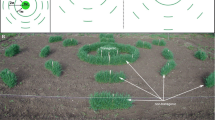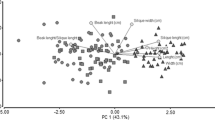Abstract
The risk of release of genetically modified oilseed rape (Brassica napus) was investigated in relation to interspecific gene flow with hoary mustard (Hirschfeldia incana). Microscopic studies showed polymorphism within the population of hoary mustard for pollen germination on oilseed rape flowers. The transgenic herbicide-resistant and a commercial cultivar of oilseed rape were not different for pollen behaviour and ovule fertilization. Pollen tube growth was slow and erratic in interspecific crosses. Fertilization efficiency of oilseed rape and hoary mustard pollen in interspecific crosses was 15% and 1.3%, respectively, of that in intraspecific crosses. This unequal efficiency in reciprocal crosses was confirmed by hybrid seed set in pods. There was no post-zygotic barrier to the development of hybrid embryos in hoary mustard pods. Up to 26 spontaneous hybrids per male sterile oilseed rape plant, and one per hoary mustard plant, were obtained in field experiments. Hybrids were identified by isozyme electrophoresis, morphology and cytology. All hybrids were triploid with 26 chromosomes, and had low fertility. They produced 0.5 seeds per plant after spontaneous backcrossing with hoary mustard. Some of these descendants were produced from unreduced gametes. Our results suggest that gene flow is likely to occur, but its actual frequency under crop growing conditions remains to be estimated.
Similar content being viewed by others
References
Akinerdem F (1991) Determination of the ploidy level of pure and mixed plant populations of sugar beet (Beta vulgaris L.) by flow cytometry. Plant Breed 107:333–337
Dale PJ, Irwin JA, Scheffler JA (1993) The experimental and commercial release of transgenic crop plants. Plant Breed 111:1–22
Darmency H (1994) The impact of hybrids between genetically modified crop plants and their related species: introgression and weediness. Mol Ecol 3:37–40
Darmency H (1995) Gene flow between crops and weeds: risk for new herbicide resistant weeds? In: De Prado R, Jorrin J (eds) Weed and crop resistance to herbicides. Kluwer, Dordrecht
Darmency H, Chadoeuf R, Fleury A, Chicouene D, Maillet J, Richarte J, Renard M, Vallee P (1995a) Survie des semences issues d'hybridation interspecifique entre le colza et la roquette batarde, et recherche des hybrides dans les populations sauvages et adventices de roquette. In: Proceedings of a Workshop on OGM, document CTPS, French Ministry of Agriculture, pp 35–42
Darmency H, Fleury A, Lefol E (1995b) Effect of transgenic release on weed biodiversity: oilseed rape and wild radish. In: Proceedings of the Brighton Crop Protection Conference — Weeds. The British Crop Protection Council, Farnham, pp 433–438
De Block M, De Brouwer D, Terming P (1989) Transformation ofBrassica napus andBrassica oleracea usingAgrobacterium tumefasciens and the expression of thebar andneo genes in transgenic plants. Plant Physiol 91:694–701
Delourme R, Eber F, Chevre AM (1989) Intergeneric hybridization ofDiplotaxis erucoides withBrassica napus L.: cytogenetic analysis of F1 and BC1 progeny. Euphytica 41:123–128
Eijlander R, Stiekema WJ (1994) Biological containment of potato (Solarium tuberosum): outcrossing to the related wild species black nightshade (Solarium nigrum) and bittersweet (Solarium dulcamara). Sex Plant Reprod 7:29–40
Ellstrand NC (1988) Pollen as a vehicle for the escape of engineered genes? TREE 3:S30-S32
Gasquez J, Compoint JP (1981) Isoenzymatic variation in populations ofChenopodium album L. resistant and susceptible to triazines. Agroecosystem 7:1–10
Issaka Magha M, Guerche P, Bregeon M, Renard M (1993) Characterization of a spontaneous rapeseed mutant tolerant to sulfonylurea and imidazolinone herbicides. Plant Breed 111:132–141
Jahiez J (1992) Techniques de Cytogénétique végétale. INRA Editions, Paris
Jørgensen RB, Andersen B (1994) Spontaneous hybridization between oilseed rape (Brassica napus) and weedyB. campestris (Brassicacea): a risk of growing genetically modified oilseed rape. Am J Bot 81:1620–1626
Kerlan MC, Chevre AM, Eber F, Baranger A, Renard M (1992) Risk assessment of outcrossing of transgenic rapeseed to related species. I. Interspecific hybrid production under optimal conditions with emphasis on pollination and fertilization. Euphytica 62:145–153
Lefol E, Danielou V, Darmency H, Kerlan MC, Vallee P, Chevre AM, Renard M, Reboud X (1991) Escape of engineered genes from rapeseed to wild brassiceae. In: Proceedings of the Brighton Crop Protection Conference - Weeds. The British Crop Protection Council, Farnham, pp 1049–1056
Lefol E, Danielou V, Darmency H (1995a) Predicting hybridization between transgenic oilseed rape and wild mustard. Field Crop Res (in press)
Lefol E, Danielou V, Darmency H, Boucher F, Maillet J, Renard M (1995b) Gene dispersal from transgenic crops. I. Growth of interspecific hybrids between oilseed rape and the wild hoary mustard. J Appl Ecol 32:803–808
Martin FW (1959) Staining and observing pollen tubes in the style by means of fluorescence. Stain Technol 34:125–128
Pelletier G, Primard C, Vedel F, Chetrit P, Remy R, Rousselle P, Renard M (1983) Intergenetic hybridization in Cruciferae by protoplast fusion. Mol Gen Genet 191:244–250
Stace CA (1975) Hybridization and the flora of the British Isles. Academic Press, London
Tiedje JM, Colwell RK, Grossman YL, Hodson RE, Lenski RE, Mack RN, Regal PJ (1989) The planned introduction of genetically engineered organisms: ecological considerations and recommendations. Ecology 70:298–315
Author information
Authors and Affiliations
Corresponding author
Rights and permissions
About this article
Cite this article
Lefol, E., Fleury, A. & Darmency, H. Gene dispersal from transgenic crops. Sexual Plant Reprod 9, 189–196 (1996). https://doi.org/10.1007/BF02173097
Received:
Accepted:
Issue Date:
DOI: https://doi.org/10.1007/BF02173097




